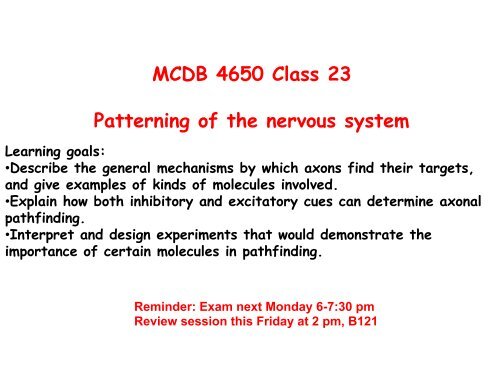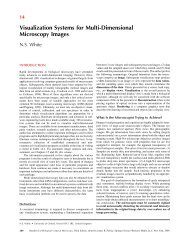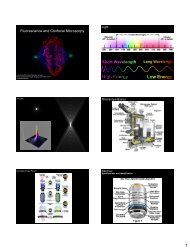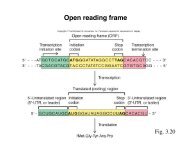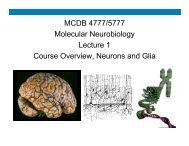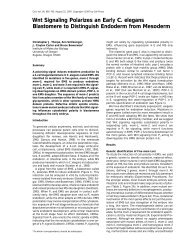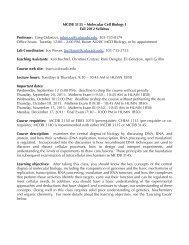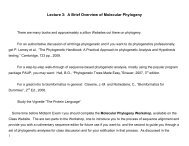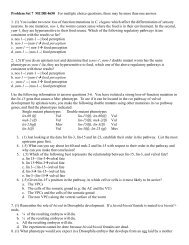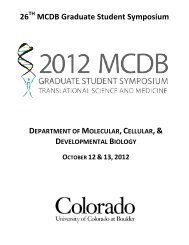You also want an ePaper? Increase the reach of your titles
YUMPU automatically turns print PDFs into web optimized ePapers that Google loves.
<strong>MCD</strong>B 4650 Class 23<br />
Patterning of the nervous system<br />
Learning goals:<br />
• Describe the general mechanisms by which axons find their targets,<br />
and give examples of kinds of molecules involved.<br />
• Explain how both inhibitory and excitatory cues can determine axonal<br />
pathfinding.<br />
• Interpret and design experiments that would demonstrate the<br />
importance of certain molecules in pathfinding.<br />
Reminder: Exam next Monday 6-7:30 pm<br />
Review session this Friday at 2 pm, B121
Defects in neuronal patterning:<br />
real examples of problems in the signaling pathways<br />
Lack of Shh<br />
Holoprosencephaly (fusion of the two sides of the brain into one)
Axons are extremely<br />
active!<br />
Anatomy of a neuron
Do neurons follow a trail of breadcrumbs?<br />
A series of signposts? A beacon?
Different groups of motor neurons<br />
innervate different classes of muscles<br />
Why?<br />
Cells in<br />
different areas<br />
of spinal cord<br />
could be<br />
committed OR<br />
Local<br />
molecules<br />
could be<br />
attracting the<br />
axons<br />
differently
Expression of different transcription factors in different<br />
regions of spinal cord
Known Mechanisms of Axon Pathfinding<br />
• Non-specific, generalized<br />
outgrowth cues<br />
(permissive):<br />
Fibronectin, laminin<br />
• Previously pioneered<br />
pathway (adhesive)<br />
N-CAM, cadherins,<br />
fasciclins<br />
• Target-Specific pathfinding:<br />
• adhesive or diffusible, repulsive or attractive
In amphibians, axons from the retina project to a brain<br />
region called the tectum<br />
Visual processing center of frog brain<br />
If the connections<br />
between retina and<br />
tectum are cut, they<br />
re-grow, providing a<br />
model for studying<br />
how axons know where<br />
to grow
Experiments that led to the hunt for guidance cues<br />
• Shine a light on retina, record electrical activity from tectum<br />
• a cell in one part of the retina always produced activity in a<br />
particular part of the tectum<br />
• Inject a visible label into neurons<br />
• an injected cell from the retina always projected to a<br />
particular place in the tectum<br />
Conclusion: Cells<br />
in retina have<br />
specific targets<br />
in the tectum
But do these cells “know” their fate<br />
(ie, are they committed to project to a certain location?<br />
nasal<br />
temporal<br />
Nasal axons: posterior tectum<br />
Temporal axons: anterior tectum<br />
Dorsal axons: lateral tectum<br />
Ventral axons: medial tectum<br />
To test commitment (1960s):<br />
Sperry and colleagues removed the eyes of frogs, severing the axonal<br />
connections.<br />
Replace eyes, rotated 180 degrees relative to their normal position
Sperry’s experiment and result:
What does this experiment demonstrate about<br />
retinal-tectal projection?<br />
a. The retinal neurons are committed to target<br />
a particular region of tectum<br />
b. The retinal neurons are not committed to<br />
target a particular region of the tectum.<br />
c. The location of the retinal neurons, not<br />
their identity, determines their path<br />
d. The neurons target the tectum randomly
Why do the axons know where to grow<br />
despite the fact that they are now in a<br />
different starting location?<br />
They have receptors that bind ligands in the environment;<br />
this information system allows them to navigate.<br />
If a neuron is committed to its fate, will its axon always go to<br />
the correct location?<br />
Not necessarily: We have to consider the molecular composition<br />
within the axon, as well as the molecular composition of the<br />
environment, and of the target!
Beacon or bread crumbs?<br />
• Chemotaxis (Beacon)<br />
long range response to a gradient of a molecule<br />
• Haptotaxis or contact-mediated guidance (bread crumbs)<br />
short range response to contact with cell/substrate (can also be<br />
a gradient)
A sampling of axon guidance molecules (do not memorize!)<br />
Ligands:<br />
always in<br />
the environment<br />
Receptors: always on<br />
the surface of the axon<br />
From B. Dickson, Science V 298, pp. 1959-1964.<br />
Domain names can be found at http://smart.emblheidelberg.de/browse.shtml
CHEMOTAXIS: growth of neurons towards a specific target based on<br />
the concnetration of a diffusible ligand<br />
How did scientists identify these molecules and figure out how they<br />
worked?
After purification of possible molecules, express these molecules in fibroblasts<br />
(normally do not generate any axon outgrowth on their own)<br />
Floor plate Fibros +<br />
Vector<br />
(control)<br />
Fibros +<br />
Netrin-1<br />
Fibros +<br />
Netrin-2
Floor<br />
plate<br />
Fibros +<br />
Vector<br />
(control)<br />
Fibros +<br />
Netrin-1<br />
Fibros +<br />
Netrin-2<br />
What else would you want to do?<br />
What can you conclude?<br />
a. Only netrin 1 is a specific<br />
chemoattractant for these<br />
neurons<br />
b. Only netrin 2 is a specific<br />
chemoattractant for these<br />
neurons<br />
c. Both netrin 1 and 2 are<br />
specific chemoattractants<br />
for these neurons<br />
d.Both netrin 1 and 2 are<br />
chemoattractants, but not<br />
necessarily specific
mRNA localization shows<br />
• a gradual gradient of Netrin-2 and Shh<br />
• a steep gradient of Netrin 1, in and directly adjacent to the floorplate
Summary of axon guidance molecules:<br />
• They often exist in a gradient, either diffusible<br />
or membrane bound<br />
• They can be attractive to one set of neurons and<br />
repulsive to another set dependent on the<br />
combination of factors present in any given neuron<br />
• Let’s return to the retino-tectal projection to<br />
explore this model further
A model for axon targeting: the retino-tectal projection<br />
in amphibians<br />
• The information from one eye is sent exclusively to the opposite<br />
side of the brain (right retina to left tectum<br />
• Each RGC axon projects to a specific spot within the tectum<br />
• Targeting within the tectum is due to haptotaxis (membrane bound<br />
ligands)
From this experiment, we could conclude:<br />
a. The nasal axons are attracted by<br />
molecules in both anterior and posterior<br />
tectum.<br />
b. The nasal axons are not repelled by<br />
molecules in the posterior tectum.<br />
c. The temporal axons are repelled by<br />
molecules in posterior tectum cells.<br />
d. The temporal axons are attracted by<br />
molecules in the anterior tectum cells.<br />
e. Each set of axons is attracted to a<br />
specific region in the tectum by a<br />
different attractive molecule<br />
To really be confident, you need more information
What to do next?<br />
• Watch the axons as they encounter Ephrin ligand<br />
• Purify proteins from different regions of the tectum.<br />
• Identify proteins present<br />
• Test the proteins to see if they act as guidance<br />
molecules<br />
• Discovered the Ephrin receptor and ligand—work through<br />
contact-mediated guidance (haptotaxis)<br />
• Ephrin Receptor was found in different concentrations<br />
across the retina, and the ligand in different<br />
concentrations across the tectum!
Ephrins and their receptors are present in<br />
a gradient across both the tectum and the retina<br />
Eph receptor<br />
in the retina<br />
Ephrin ligand<br />
in the tectum
High EphR<br />
(low to high Eph ligand)<br />
Low EphR<br />
Why do the axons from the nasal retina go to the<br />
posterior tectum, rather than being stopped in the<br />
anterior tectum?<br />
a. The nasal axons are more sensitive to the Eph ligands<br />
b. The nasal axons are less sensitive to the ligands<br />
c. The nasal axons are unresponsive to the Eph ligand<br />
d. None of the above
Watching neurons as they encountered Eph targets also showed<br />
“repulsion”<br />
this was the first example of repulsive activity working as<br />
guidance<br />
In this case, repulsion is based on both the density of the receptors,<br />
and the concentration of the ligand<br />
Axons with a low concentration of receptors are not repelled by a low<br />
concentration of ligand, so they project to the posterior tectum, and<br />
synapse there.
Cool cre-lox system for labeling neurons and their axonal projections


